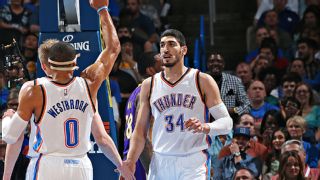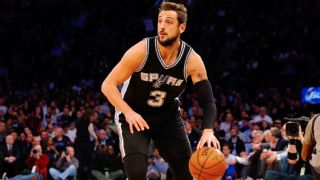|
Yesterday we described an RPM-based method of estimating the surplus value of each NBA contract -- which occurs when a player contributes more on the court than he's actually being paid to produce. Today we'll look at four teams that managed to create negative surplus value this summer -- to pay their newly signed free agents far more than the value they're expected to generate. No Thunderous applauseYes, the same Oklahoma City Thunder brass who famously refused to max out James Harden in 2012 just extended a max offer to Enes Kanter. The comparison makes for bad optics -- especially with Harden's emergence as an MVP-caliber superstar -- but the two scenarios aren't truly comparable. For one thing, the fiscal handwringing of small market teams three years ago feels like a distant memory in today's expansive fiscal climate. Besides, only one question really matters for our analysis: Does the Kanter deal make sense, today, on its own merits? It's not hard to see the positive case. The guy put up some huge numbers -- nearly 19 points and 11 boards per game -- during his 26 games with OKC down the stretch last season. And because he's only 23, we can still expect some improvement ahead. Shouldn't a young double-double machine like Kanter generate surplus value for the Thunder, even on a max contract? Unfortunately, Kanter has a reputation among league insiders as a defensive sieve, and RPM confirms the perception. Among all NBA bigs, Kanter's horrid defensive RPM is rivaled only by Andrea Bargnani, with an impact so toxic it drops his total RPM impact (-2.84) well below replacement level (i.e., the play we could expect from a minimum-salary call-up from D League, free agency, or overseas). It's probably no coincidence, then, that Utah started playing like a playoff team immediately after trading away Kanter last season. It's similarly informative that OKC's defensive efficiency plummeted when Kanter was on the floor, with the team yielding 7.9 more points per 100 possessions. Bottom line: Kanter has the lowest -- i.e., the most negative -- projected surplus value of any free agent signed this summer. Our analysis suggests that he's being overpaid to the tune of $68 million over the next 5 years. If this projection is even remotely accurate, his gaudy contract should eventually come to be seen as an egregious albatross. But who knows? Maybe Kanter will confound the forecast, make great strides on both ends of the court, and emerge as a solid value signing for OKC. We hope so. Because if not, the inevitable Kanter-Harden comparisons will grow increasingly uncomfortable for Sam Presti and company. Royally Messed Up? The Sacramento Kings' drama-filled summer has already been well chronicled and vigorously criticized. It's not our intent to pile on. In fact, we're happy to note that two of the team's recent free agent signees -- Kosta Koufos and Omri Casspi -- combine for about $4 million in projected surplus value. That's really not much in the buyer's market of this year's free agency, but at least it reflects competent decision-making. Unfortunately, Sacramento's other free agent transactions rate worse. Much worse. And they bring the team's total free agency surplus value down to an abysmal $-43.2 million. Consider the Rajon Rondo signing. Not only did the mercurial point guard lose his All-Star form following knee surgery in 2013, but his play has so thoroughly devolved in the interim that he now rates far below replacement level in RPM terms. Rondo actually hurt Boston, and then Dallas, with his play last season. His impact on offensive spacing was particularly devastating -- the result of legendarily poor shooting (.460 true shooting percentage) and difficulty getting to the rim. It makes sense, then, that the Mavericks were happy to part ways with Rondo even before last season's playoff run drew to a close. And yet -- remarkably -- the Kings decided to shell out $9.5 million for his services next season. Sacramento's addition of sharpshooter Marco Belinelli rates even worse in our analysis. While he's a reasonably efficient offensive player -- with a true shooting percentage (55.3) just above league average last season -- Belinelli's defensive lapses cost the Spurs dearly. His defensive RPM (-3.12) actually lands him among the worst wing defenders in the NBA. And because his total RPM impact is well below replacement level, Belinelli's new $19 million, three-year contract rates in our analysis as money the Kings have essentially wasted. In fact, Belinelli could serve as a poster boy for enduring inefficiencies for in the NBA talent market, especially the fact that offensive contributions still greatly outweigh defensive impact in determining player salaries. Belinelli has one nice offensive skill -- outside shooting (39 percent on 3s in his career) -- and on that basis, the Kings will pay him over $6 million a year despite myriad defensive liabilities. RPM suggests the Kings could expect better overall play (especially on the defensive end) from a no-name minimum-contract wing, but Sacramento remains one of the teams willing to overpay for offensive talent alone. Another Net Loss The Nets franchise is legendary for spending gobs of owner Mikhail Prokhorov's money without that much to show for it. But with the organization's recent shift into cost-cutting mode after years of profligacy, this summer actually promised to be different. And yet according to our analysis the Nets have still managed to overspend in free agency more than any other team. Specifically, Brooklyn's six major signings have generated a whopping $74 million deficit in surplus value. In other words, the team has spent far more on these players than the real value they're likely getting in return. It starts with injury-prone center Brook Lopez and his new three-year, $63 million deal. Over the past four seasons, Lopez has averaged only about 1,250 minutes per season -- about half the playing time of a healthy full-time starter. While our forecast gave Lopez credit for his increased load last season (2,100 minutes), it remained a moderately skeptical about his long-term health outlook, especially given the poor track record of 7-footers battling foot problems. But even if Lopez somehow proves capable of staying on the court for another 2,100 minutes during each of the next 3 seasons, his surprisingly pedestrian Predictive RPM (+0.24) is still far too low to justify his new $21 million-per-year salary. Remarkably, despite his rim protection, skilled post game and advanced ability to play facing the basket, Lopez no longer moves the needle in terms of team efficiency. Three seasons ago (2012-13), prior to the injury that derailed his 2013-14 campaign, Lopez posted a borderline All-Star-level RPM of +3.6. But since that time his usage rate, true shooting percentage, blocks, free throws, and assists have all fallen, and the team has played roughly as well -- or poorly -- when he's on the bench as it does when he's on the court. According to our valuation analysis, Brooklyn's other summer missteps were less serious, but the team somehow managed to overpay for nearly every player they acquired. For example, they're paying Thaddeus Young -- essentially a league-average player (+0.34 RPM) -- $14 million a year for a guaranteed four years. And they've signed three players, Andrea Bargnani, Thomas Robinson and Shane Larkin, whose contributions project far below replacement level according to RPM. Even on minimum contracts, such players are overpaid. So, even though the Nets are now committed to greater fiscal responsibility, their free agency transactions have done nothing to create more projected surplus value on the roster. Instead, it looked more like: same old, same old. A Knicks Rebound in Free Agency? The Knicks have been aggressive suitors in the summer free agency market, inking six players to new contracts. Unfortunately, only one of them is projected to create any real surplus value, while two deals rate as big overpays. The other three are basically a wash. Let's start with the good news. Kyle O'Quinn looks like a potential steal at $11.74 million for three years (with a fourth-year player option). The athletic rim protector spent his first three seasons as a backup big for Orlando. But with his improving offensive game and respectable RPM impact (+0.45), O'Quinn could conceivably emerge as a quality starter for New York. But even if he becomes nothing more than a 20-minutes-per-game rotation big, he'll still generate $12 million in projected surplus value for the Knicks. Unfortunately, O'Quinn is most effective at the center position, the same spot now occupied by Robin Lopez, whom the team just signed at a cost of over $12 million per year. Lopez is a quality big -- a much better defender than his brother Brook, though less skilled offensively -- and he's probably worthy of his new contract. But at a predicted RPM impact of only +1.5 next season, with some expected age-related decline thereafter, the 27-year-old rates as merely a break-even signee in surplus value terms. By far the team's worst signings are those of Arron Afflalo ($16 million) and Derrick Williams ($10 million), both of whom are projected to contribute at below replacement level due to particularly poor defensive play. While Afflalo was once regarded as a lockdown perimeter defender, advanced metrics -- especially RPM -- suggest that his impact in recent seasons has been a decidedly negative. To summarize: Despite the Knicks' smart pickup of Kyle O'Quinn, the team is projected at a net -$22 million in surplus value from their six free agent transactions. In other words, they likely overspent for the modest infusion of talent they acquired. In so doing, they made little apparent progress on the path back toward NBA respectability.
|


